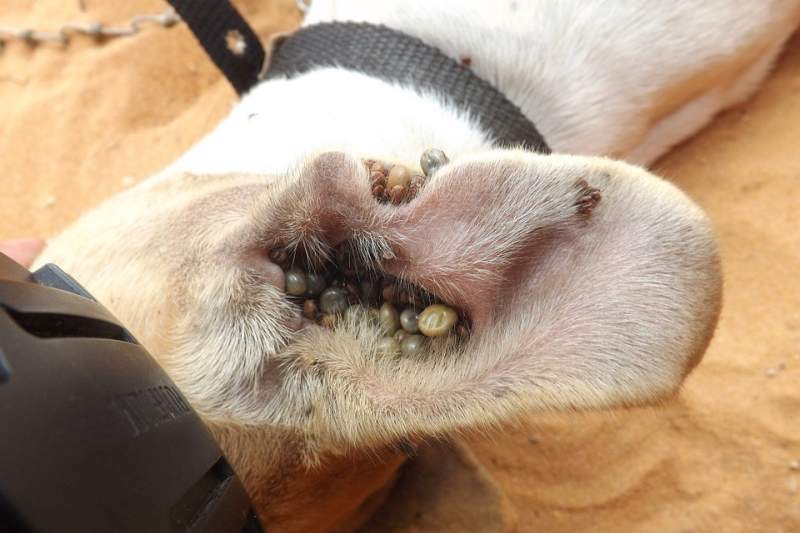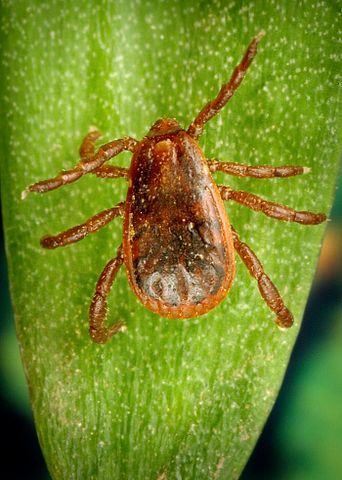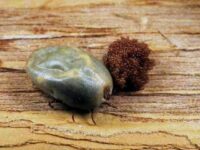The brown dog tick (Rhipicephalus sanguineus) or kennel tick is like all ticks a blood-sucking parasite that can transmit dangerous diseases to its host. The Brown Dog Tick originates from North Africa but has spread throughout the world and is now in fact the most widespread tick in the world. The species will probably continue to spread because of climate change. It has also adapted well to human habitats and can complete its entire life cycle indoors. The brown dog tick primarily prefers dogs as its host but also infests other warm-blooded animals, including humans, when there are no dogs around.
What do brown dog ticks look like?
The brown dog tick (Rhipicephalus sanguineus) belongs to the family of Ixodidae or Shield Ticks. As a shield tick, the brown dog tick looks like a typical hard tick and can easily be confused with a deer tick, American dog tick, or gulf coast tick.
However, if you take a closer look, you notice that the body of the brown dog tick is slightly elongated in shape and has a red-brown color. The legs are reddish-brown. In females, the capituli (the body part where mouthparts are attached) is colored slightly dark brown.
The larvae are tiny and difficult to see after hatching. Nymphs are about half a millimeter to 1 millimeter in size. The adult ticks are about 3.5 millimeters in size if they haven’t eaten yet. A female brown dog tick engorged after a meal of blood can grow up to 12 millimeters long, but the male representatives of this species do not grow larger than four millimeters even after a blood meal.
Where are brown dog ticks found?
The brown dog tick, also known as the Kennel tick, is originally native to North Africa but has now spread worldwide. By being able to survive in dry places without much moisture, the brown dog tick, unlike most other ticks, can easily survive and complete its whole lifecycle in buildings and apartments.
Brown dog ticks are mainly found in places where dogs spend the night. They are usually found hidden in cracks and crevices in walls, floors, furniture, and under carpets.
If they are not disturbed in their hiding places and are able to take a blood meal occasionally, they can multiply extremely which leads to mass infestations that are difficult to get rid of.
Brown dog tick life cycle
Like other types of ticks, dog ticks go through several phases in their development. The first stage of this is the larva, the second stage is known as the nymph and the third finally represents the sexually mature animal. During the first two stages of development, dog ticks are about 0.5 to one millimeter in size and show a translucent, pale brown color.
All ticks go through several molts, in each of these development stages, the brown dog tick needs a blood meal before each transition to the next development stage (from larva to nymph and from nymph to adult). The actual feeding process in each stage can then take a couple of days to about two weeks.
Do brown dog ticks bite humans?
As the name suggests, the brown dog tick’s most preferred host animal is the dog. The tick species can also parasitize on numerous other animals, including sheep, goats, cattle, pigs, cats, and other small mammals (such as hares or rabbits). However, the risk of being bitten by the species increases significantly if there is a mass infestation in an indoor living space. And if the ticks cannot find another suitable host for a long time, the risk of them biting a person increases. After all, the desire for a blood meal drives the tick.
Brown dog tick bite symptoms
A tick bite is easy to spot as such if the tick is still lodged in the bite site and is still sucking blood. Depending on how long the tick has been sucking blood and how full it is, you can recognize a small, or a pea-sized foreign body clinging to the skin.
But if the tick has already finished feeding and is fallen off, it can be difficult to recognize the small wound as a tick bite. There are no typical brown dog tick bite symptoms. The bite itself is usually painless, and tick bites usually don’t itch. The wound initially appears as a tiny puncture wound that usually heals quickly, provided its keep clean to prevent infection.
In any case, you should watch the bite site. And if you suspect that a small previously undetected wound could be from a tick bite, then watch it too. Mark the site with a waterproof pen and take a photo of it. Pay attention to any changes in the wound that do not correspond to a normal healing process. In the days and weeks after the tick bite, you should monitor yourself (or your pet) for any abnormalities or symptoms. If in doubt, go to the doctor.

Brown dog tick diseases
The brown dog tick is the carrier of several diseases. As with most tick-borne diseases, the longer the tick stays in the wound and sucks blood, the greater the risk of transmission. The probability of transmission also varies depending on the geographical location, since in some areas tick populations carry more pathogens in them.
Most Common Diseases transmitted by brown dog tick to dogs
Babesiosis
Infection in dogs with Babesia Canis Bacteria causes a mostly mild form of babesiosis in dogs.
Symptoms of the infection can include fever, lethargy, weakness, vomiting, weight loss, anorexia, pale mucous membranes, and dark discoloration of the urine.
Ehrlichiosis
Canine Ehrlichiosis is one of the most common tick-borne diseases of dogs, usually caused by the bacterium Ehrlichia canis. It occurs throughout the continental USA.
The symptoms can be very diverse. After the incubation period, the animals show recurrent fever, nosebleeds, slimy-purulent nasal discharge, vomiting, exhaustion, shortness of breath, swelling of the lymph nodes, possibly muscle twitching, and cramps. The disease can usually be successfully combated with strong antibiotics.
Hepatozoonosis
American canine hepatozoonosis is a tick-borne disease that spreads throughout the southeast and the southern United States. The disease is triggered by hepatozoa, unicellular parasites that live in the intestines of their host. Infection can occur if an animal eats an infected tick – the disease is not spread by tick bites.
Symptoms can include fever, lethargy, weight loss, enlarged lymph nodes, organ damage. Without treatment, H. americanum can seriously damage blood vessels and kidneys. The disease is incurable but can be managed with the right medicines.
Brown dog tick diseases caused in humans
People are rarely bitten by the brown dog tick. However, if the brown dog tick bites a human, it can transmit Rickettsia rickettsii, the bacteria responsible for causing Rocky Mountain spotted fever in humans.
Can brown dog ticks carry Lyme disease?
So far, it has not been shown that the brown dog tick is responsible for the transmission of Lyme borreliosis to humans. See details: University of Florida
How to Remove Brown Dog Ticks
Pulling a brown dog tick out is basically the same as removing all ticks.
Use tweezers: Grab the tick as close as possible to the skin near the mouthparts. pull out the tick carefully and in a controlled manner at a perpendicular angle to the skin without squeezing the body of the tick.
With a tick card: Place the tick card flat on the skin. Push the card with the V-shaped notch against the tick and keep pushing evenly until the tick comes off.
With a tick hook, choose the correct size hook. Push the hook slowly and carefully under the tick. Then carefully pull out the tick. There are also recommendations to twist the hook two or three times to twist the tick out of the wound.
With your fingers: If you don’t have a tick removal tool, you can remove a tick with your thumb and forefinger. But be careful to make sure that the body of the tick is not squashed. This method is very difficult for nymphs, but possible for large ticks.
After removal, disinfect the wound, cover it and check it daily.
What to do with the tick?
If you have successfully removed a tick from the skin, it is best to kill the parasite. Drowning it in rubbing alcohol will do so quickly, then put it in a small container and freeze the dead tick. In this way, the tick can later be examined for pathogens if any complications should arise afterward.
To kill a tick, you can also put it in a small paper bag or fold it in a piece of paper, and then crush it or burn the whole thing.
If you crush the tick, you must make sure that you do not come into contact with the body secretions. In any case, wash your hands thoroughly and disinfect them afterward.
Under no circumstances should you simply snip the tick away, throw it in the trash can or flush it down the toilet. Ticks are really tough.
What kills brown dog ticks?
As explained above, you can easily kill a kennel tick that has been pulled from the skin. The real problem is to kill brown dog ticks that are hidden in niches and cracks around the house or in a kennel.
First, you have to tidy up everything and clean the house. In order to kill the ticks and their eggs in hard-to-reach places, the only thing that really helps is to use pesticides.
Various sprays and dusters are the means of choice here. The most effective are insecticides based on Pyrethrin (e.g., Amitraz, Fipronil, Permethrin, Deltamethrin, Propoxur, Pyriprole, etc.). To effectively get rid of and kill as many ticks and their eggs as possible, you must spray every room where you have found ticks and where you suspect ticks to be. In the worst case, you have to spray every room in the whole house. Be sure to follow the instructions exactly.
If that is too complicated for you, then it might be better to contract a professional exterminator.
Products to Treat Rooms and Large Areas
Last update on 2025-06-22 / Affiliate links / Images from Amazon Product Advertising API
Shampoo or powder to treat dogs to rid them of ticks and fleas
Last update on 2025-06-30 / Affiliate links / Images from Amazon Product Advertising API
Protect your pets from the Brown Dog Tick
After successful treatment of an acute tick infestation, tick collars or spot-on preparations are the most effective protection to reduce the risk of a new infestation. Depending on the product, collars or spot-ons offer protection that works for several months.
But tick protection is not only important in summer but especially in the case of brown dog ticks all year round.
References and more info:
Biology and ecology of the brown dog tick, Rhipicephalus sanguineus parasitesandvectors.biomedcentral.com/articles/10.1186/1756-3305-3-26









